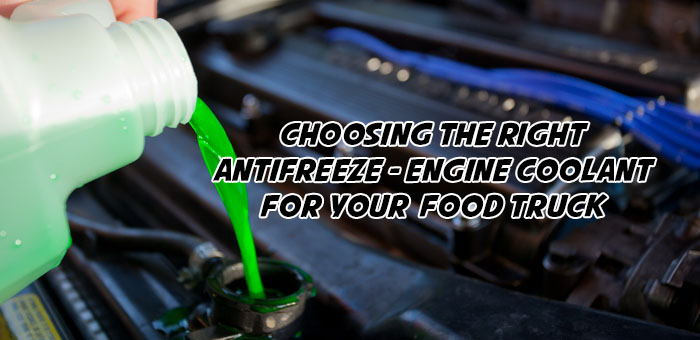Antifreeze and engine coolant are very important in all vehicles. Food trucks, however, have special demands for antifreeze and engine coolant, since they’re often hauling larger loads. This makes it important to know about food truck antifreeze or engine coolant for your truck and to be able to pick one that will work well. This will help eliminate the risk of overheating and damaging your engine.
Choosing The Right Food Truck Antifreeze / Engine Coolant
With the coldest winter months here, you need to do more to your food truck in order to keep them safe, effective and in perfect condition as the temperatures begin to drop. Antifreeze is a liquid that is added to the truck’s engine cooling system in the colder months.
Food truck antifreeze is used in the winter as the liquid lowers the waters freezing point, and thus the cooling system is less likely to become frozen. Frozen cooling systems can be the cause of your vehicle to break down, so it’s very important you take these tips into consideration and use the right antifreeze in the winter months.
Types Of Coolant
There are two basic types of food truck antifreeze, for modern vehicles. They are ethylene glycol and propylene glycol.
- Ethylene glycol. This is highly toxic and has to be used very carefully. Because of this, it must not to be drained into the water system.
- Propylene glycol. More widely used and classed as safe by the FDA. It’s used in coolants of all types including aircraft de-icing, and porta-Johns. However, as with ethylene glycol, it should not be drained into the water system.
Use the general rule that your food truck antifreeze should be mixed with water in a 50/50 ratio. You should never have water as less than 40% of the mixture. If the wrong mixture of antifreeze or coolant is used, rust and corrosion can result as well as cylinder wall cavitation that can eventually kill your food truck engine.
Freezing Point
Vendors in extremely cold climates, will find propylene glycol needs to be in a higher concentration as an engine coolant since it’s not as efficient in lowering the freezing point.
Mixing Food Truck Antifreeze
You should never use water from the tap to dilute concentrated coolant or antifreeze because it can cause scaling in the engine. Instead, use distilled water. Most truck manufacturers recommend using engine coolant that’s pre-mixed. This is because you know you’re getting the right mixture.
Labels
It’s important to read the label to know what type of antifreeze you’re buying and what type of inhibitors it contains. It should be formulated so it meets national and international testing standards. You can use recycled engine coolant as long as it meets testing standards but it’s not recommended.
Color
Despite the rainbow of colors, all antifreeze starts out colorless. Dyes are added to differentiate one brand from another, and to help us see how much coolant is in that reservoir. Unfortunately, there is no universal, standardized coolant color code.
RELATED: Winter Food Truck Maintenance Checklist
The Bottom Line
Oil is often called the lifeblood of engines. Unfortunately, you can forget about the other lifeblood of your engine, antifreeze. Coolant/Antifreeze is critical to the proper function of any engine, especially diesels.
The cooling system operates at higher temperatures, making careful cooling system maintenance necessary to avoid engine damage due to boiling, deposits, or pitting. Improper mixtures of food truck antifreeze can cause corrosion, rust, and overheating. Keep your food truck on the road throughout the year by selecting the right food truck antifreeze or coolant for your truck.
Do you have any additional food truck antifreeze tips? Share your thoughts below or on social media. Facebook | Twitter




